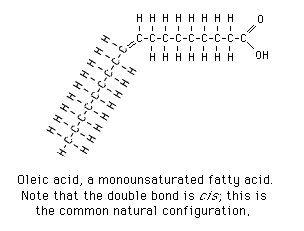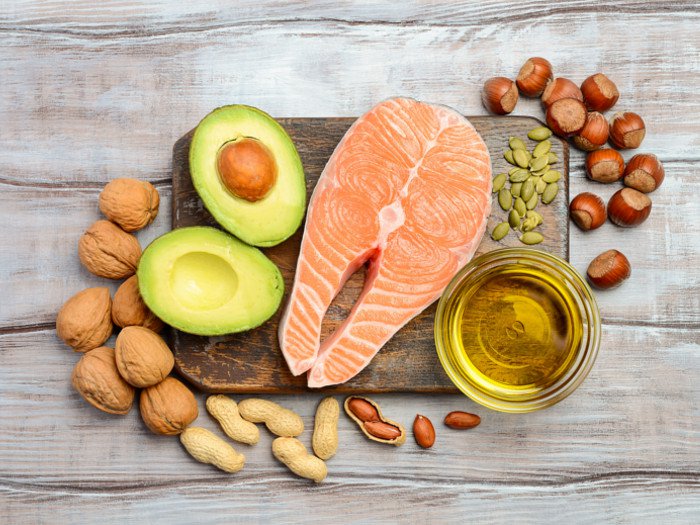ไขมันไม่อิ่มตัวเชิงเดี่ยว monounsaturated fats

เป็นกรดไขมันที่มีธาตุ C ต่อกันด้วย Double bond เพียงหนึ่งตำแหน่ง การรับประทานอาหารไขมันอิ่มตัวจะ เพิ่มระดับไขมัน LDL Cholesterol ร้อยละ4 ในขณะที่รับประทานรับประทานไขมันไม่อิ่มตัวเชิงเดี่ยวจะลด LDL Cholesterol ได้ ร้อยละ5 และสามารถลดระดับความดันโลหิต ทำให้ไขมันไม่อิ่มตัวเชิงเดี่ยวป้องกันการเกิดโรคหลอดเลือดตีบ ป้องกันการเกิดโรคหัวใจ
ผลดีของไขมันไม่อิ่มตัวเชิงเดี่ยว monounsaturated fats
- ไขมัน Monounsaturated fats จะลดคอเลสเตอรอล LDL cholesterol ในเลือด ซึ่งจะลดความเสี่ยงของการเกิดโรคหัวใจขาดเลือด และโรคหลอดเลือดสมอง
- มีกรดไขมันทีจำเป็นต่อร่างกาย และวิตามินอีซึ่งเป็นสารต้านอนุมูลอิสระ
- ไขมันไม่อิ่มตัวเชิงเดี่ยวจะเพิ่มความไวในการตอบสนองต่ออินซูลินทำให้ควบคุมเบาหวานได้ดีขึ้น
- ลดการเกิดมะเร็งเต้านม เป็นการศึกษาที่ประเทศสวีเด็นพบว่าใช้น้ำมันมะกอกมีการเกิดมะเร็งเต้านมน้อยกว่าไขมันไม่อิ่มตัวเชิงซ้อน มีการกล่าวว่าจะลดการเกิดมะเร็งต่อมลูกหมาก
- ลดน้ำหนักเมื่อเทียบกับการใช้ไขมันไม่อิ่มตัวเชิงซ้อน
- ลดการอักเสบของข้อจากโรครูมาตอยด์
- ลดการเกิดภาวะอ้วนลงพุง
อาหารที่อุดมไปด้วยไขมัน monounsaturated fats
พบได้ในพืชและเนื้อสัตว์ โดยมีการศึกษาพบว่าไขมันไม่อิ่มตัวเชิงเดี่ยวจากพืชโดยเฉพาะจากน้ำมันมะกอกจะดีกว่าจากสัตว์
- น้ำมันมะกอก olive oil
- น้ำมัน canola oil
- น้ำมันถั่ว peanut oil,
- น้ำมันดอกคำฝอย safflower oil
- น้ำมันงา sesame oil.
- avocados
- เนยถั่ว peanut butter
- ถั่วชนิดต่างๆ
- อาหารที่มีไขมันMonounsaturatedได้แก่ avocados, nuts, olive, peanut
ตัวอย่างอาหารที่มีไขมันไม่อิ่มตัวเชิงเดี่ยวในอาหาร 100 กรัม
- น้ำมันมะกอก 73.1 grams
- ถั่ว Almonds: 33.6 grams
- ถั่ว Cashews: 27.3 grams
- ถั่วลิสง Peanuts: 24.7 grams
- ถั่ว Pistachios: 24.2 grams
- Olives: 15 grams
- เมล็ดฟักทอง: 13.1 grams
- หมู 10.7 grams
- Avocados: 9.8 grams
- เม็ดทานตะวัน 9.5 grams
- ไข่ 4 grams
ข้อสำคัญคือน้ำมันทุกชนิดจะให้พลังงานเท่ากันคือ9 กิโลแคลอรี่ต่อน้ำมัน 1 กรัม
คำแนะนำ
เพื่อสุขภาพควรจะใช้น้ำมันที่มีไขมันไม่อิ่มตัวเชิงเดี่ยว monounsaturated ทดแทนไขมันไม่อิ่มตัวเชิงซ้อน polyunsaturated fats และไขมัอิ่มตัว ส่วนน้ำมันทรานซ์ไม่ควรจะรับประทาน
เราจะรับประทานไขมันได้เท่าไร
- สมาคมโภชนาการอเมริกาปี2015 แนะนำให้ประชาชนบริโภคไขมันประมาณร้อย25-30 ของพลังงานที่ได้รับในแต่ละวัน
- โดยแบ่งเป็นไขมันไม่อิ่มตัวไม่เกินร้อยละ10ของพลังงานที่ได้รับทั้งหมด (สำหรับพลังงานที่คนได้รับประมาณ200แคลอรีจะรับไขมันอิ่มตัวไม่เกิน16-22กรัม)
- ที่เหลือให้รับประทานไขมันไม่อิ่มตัวเชิงเดี่ยวและไขมันไม่อิ่มตัวเชิงซ้อน
- ควรจะอ่านฉลากอาหารเพื่อที่จะทราบปริมาณไขมันในอาหาร โดยเฉพาะไขมันอิ่มตัวและไขมันทรานส์ไม่ควรจะรับประทานเกินกำหนด
กรดไขมันที่เป็นส่วนประกอบของไขมันไม่อิ่มตัวเชิงเดี่ยว
กรดไขมัน Oleic acid เป็นกรดไขมันที่พบบ่อยที่สุดประมาณร้อยละ 90 ส่วนที่เหลือได้แก่ palmitoleic acid และ vaccenic acid.
- Mark Wolk, Alicia, “A Prospective Study of Association of Monounsaturated Fat and Other Types of Fat With Risk of Breast Cancer,” Archives of Internal Medicine. http://archinte.ama-assn.org/cgi/content/abstract/158/1/41
- Donaghue, K, “Beneficial effects of increasing monounsaturated fat intake in adolescents with type 1 diabetes,” Diabetes Research and Clinical Practice. http://linkinghub.elsevier.com/retrieve/pii/S0168822700001236
- American Heart Association http://www.americanheart.org/presenter.jhtml?identifier=3045795
- Mediterranean Diet Offers Multiple Benefits to Arthritis Sufferers http://whfoods.org/genpage.php?tname=btnews&dbid=13#article
- Manzella, Deborah, “A Diet Rich in MUFA’s Can Reduce Belly Fat,” About.com. http://diabetes.about.com/b/2008/01/13/mufa-rich-diet-can-reduce-belly-fat.htm
Monounsaturated fat is a type of dietary fat. It is one of the healthy fats, along with polyunsaturated fat. Monounsaturated fats are liquid at room temperature but start to harden when chilled.
Saturated fats and trans fats are solid at room temperature. These unhealthy fats can increase your risk for heart disease and other health problems.
Monounsaturated fats are found in plant foods, such as nuts, avocados, and vegetable oils. Eating moderate amounts of monounsaturated (and polyunsaturated) fats in place of saturated and trans fats can benefit your health.
How Monounsaturated Fats Affect Your Health
Monounsaturated fats are good for your health in several ways:
- They can help lower your LDL (bad) cholesterol level. Cholesterol is a soft, waxy substance that can cause clogged, or blocked, arteries (blood vessels). Keeping your LDL level low reduces your risk for heart disease and stroke.
- Monounsaturated fats help develop and maintain your cells.
How Much you can eat
Your body needs some fats for energy and other functions. Monounsaturated fats are a healthy choice.
How much should you get every day? Here are recommendations from the 2020-2025 Dietary Guidelines for Americans:
- Aim for getting no more than 10% of your total daily calories from saturated fat (found in red meat, butter, cheese, and whole-fat dairy products). For a 2,000 calorie diet, that is a total of 200 calories, or 22 grams a day.
- Keep total fat consumption to no more than 25% to 30% of your daily calories. This includes monounsaturated and polyunsaturated fats.
Eating healthier fats is good for your health. But eating too much fat can lead to weight gain. All fats contain 9 calories per gram of fat. This is more than twice the amount found in carbohydrates and protein.
It is not enough to add foods high in unsaturated fats to a diet filled with unhealthy foods and fats. Instead, replace saturated or trans fats with healthier, unsaturated fats.
Reading Nutrition Labels
All packaged foods have a nutrition label that includes fat content. Reading food labels can help you keep track of how much fat you eat.
- Check the total fat in one serving. Be sure to add up the number of servings you will eat in one sitting.
- Look closely at the amount of saturated fat and trans fat in a serving. The rest is unsaturated fat. Some labels will list the monounsaturated fat content, some will not.
- Make sure most of your daily fats are from monounsaturated and polyunsaturated sources.
- Many fast-food restaurants also provide nutrition information on their menus. If you do not see it posted, ask your server. You also may be able to find it on the restaurant's website.
Making Healthy Food Choices
Most foods have a combination of all types of fats. Some have higher amounts of healthy fats than others. Foods and oils with higher amounts of monounsaturated fats include:
- Nuts
- Avocado
- Canola oil
- Olive oil
- Safflower oil (high oleic)
- Sunflower oil
- Peanut oil and butter
- Sesame oil
To get the health benefits, you need to replace unhealthy fats with healthy fats. Here are some ideas:
- Eat nuts instead of cookies for a snack. Be sure to keep your portion small, as nuts are high in calories.
- Add avocado to salads and sandwiches instead of dressings and mayonnaise.
- Replace butter and solid fats with olive, avocado, or canola oil.
Alternative Names
Monounsaturated fatty acid; MUFA; Oleic acid; Cholesterol - monounsaturated fat; Atherosclerosis - monounsaturated fat; Hardening of the arteries - monounsaturated fat; Hyperlipidemia - monounsaturated fat; Hypercholesterolemia - monounsaturated fat; Coronary artery disease - monounsaturated fat; Heart disease - monounsaturated fat; Peripheral artery disease - monounsaturated fat; PAD - monounsaturated fat; Stroke - monounsaturated fat; CAD - monounsaturated fat; Heart healthy diet - monounsaturated fat
References
Grundy SM, Stone NJ, Bailey AL, et al. 2018 AHA/ACC/AACVPR/AAPA/ABC/ACPM/ADA/AGS/APhA/ASPC/NLA/PCNA Guideline on the management of blood cholesterol: a report of the American College of Cardiology/American Heart Association Task Force on Clinical Practice Guidelines. J Am Coll Cardiol. 2019;73(24):e285-e350. PMID: 30423393 pubmed.ncbi.nlm.nih.gov/30423393/.
Hensrud DD, Heimburger DC. Nutrition's interface with health and disease. In: Goldman L, Schafer AI, eds. Goldman-Cecil Medicine. 26th ed. Philadelphia, PA: Elsevier; 2020:chap 202.
Mozaffarian D. Nutrition and cardiovascular and metabolic diseases. In: Libby P, Bonow RO, Mann DL, Tomaselli GF, Bhatt DL, Solomon SD, eds. Braunwald's Heart Disease: A Textbook of Cardiovascular Medicine. 12th ed. Philadelphia, PA: Elsevier; 2022:chap 29.
U.S. Department of Agriculture and U.S. Department of Health and Human Services. Dietary Guidelines for Americans, 2020-2025. 9th Edition. December 2020. Available at DietaryGuidelines.gov. Accessed September 6, 2022.
Review Date 6/22/2022
Updated by: Stefania Manetti, RD/N, CDCES, RYT200, My Vita Sana LLC - Nourish and heal through food, San Jose, CA. Review provided by VeriMed Healthcare Network. Also reviewed by David C. Dugdale, MD, Medical Director, Brenda Conaway, Editorial Director, and the A.D.A.M. Editorial team.




